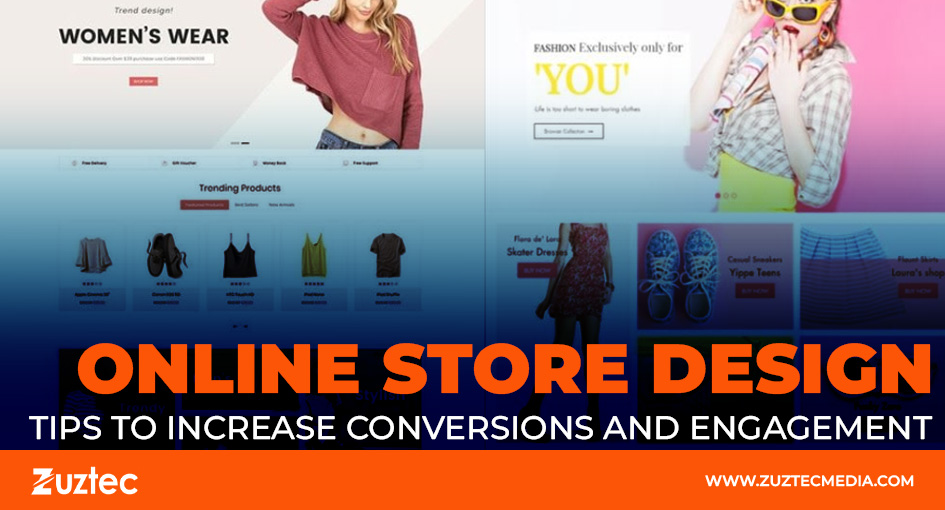
Online Store Design Tips To Increase Conversions And Engagement
A visually appealing and user-friendly website is essential for drawing in and keeping customers in the fiercely competitive e-commerce market of today. No matter how great your products are, poor presentation and clunky navigation can quickly drive potential buyers away. That’s where online store design comes into play—it’s more than just aesthetics; it’s a tool for boosting engagement, driving conversions, and creating trust with your audience. The design of your online store serves as the first impression for new visitors. Elements such as clear menus, organized product categories, high-quality images, and easy-to-use search functions are essential parts of an effective design strategy.
Moreover, a good design of an online store is mobile-friendly. With more people shopping on their phones, your e-commerce site must adapt to different screen sizes without compromising functionality. A seamless mobile experience keeps shoppers engaged longer and increases the likelihood of purchase. Combined with fast load times and intuitive checkout processes, great design can significantly enhance user satisfaction and business results.
Finally, your website should reflect your brand identity. Colors, fonts, layout styles, and even the tone of your content should all align with the image you want to present. By prioritizing store design from the beginning, you lay a strong foundation for long-term e-commerce success.
Online Store Design Shapes How Users Interact With Your Brand
Design is more than decoration; it’s the structure that supports your entire ecommerce operation. The design of an online store determines how your customers find products, navigate through categories, and move through the buying process. An effective layout guides users naturally, removing confusion and reducing the number of clicks it takes to reach their goal.
Featuring best-selling items, limited-time offers, and clear calls-to-action encourages users to explore more. Product pages should be clean and information-rich, with detailed descriptions, multiple images, and clear pricing. The add-to-cart button should stand out, while cross-sell options can help increase average order value.
Navigation should always be simple and intuitive. A sticky header with your main categories, a visible search bar, and breadcrumb links all contribute to a smoother browsing experience. Filters and sorting options are especially useful for stores with large inventories, allowing users to narrow down their search efficiently.
Loading speed also plays a big role in design performance. If your site takes more than a few seconds to load, many visitors will leave before they even see your products. To avoid this, designers and developers should optimize image sizes, minimize scripts, and use lightweight themes that don’t compromise quality.
Best Practices For Improving Your Store’s User Experience
User experience, or UX, is at the heart of successful online stores. Everything from color choices to font size influences how a visitor feels when browsing your site. Consistent branding, clean design, and logical layouts all contribute to a more enjoyable shopping experience.
Trust-building elements are also key. Displaying customer reviews, trust badges, return policies, and contact information reassures shoppers that they’re making a safe purchase. Adding a live chat feature can further support customer service efforts and resolve any concerns in real time.
Midway through your e-commerce strategy, online store design becomes the tool that either supports or hinders growth. For example, if your analytics show a high bounce rate or low time on site, it’s often a design issue rather than a product problem. Adjusting colors, CTAs, layout, and content hierarchy can dramatically improve performance metrics.
A/B testing is a practical way to refine your store design. By testing different versions of product pages, banners, or checkout flows, you can identify what works best for your audience. Over time, these small changes can lead to significant increases in sales and user satisfaction.
Avoiding Common Mistakes In E-commerce Store Design
One common mistake in the design of an online store is focusing too heavily on visuals while neglecting function. While a beautiful website may draw attention, it must also deliver a seamless experience. Avoid using too many animations or interactive elements that slow down the site or make it confusing to navigate.
Another issue is poor mobile responsiveness. If your site is difficult to use on a smartphone, you risk losing a large segment of potential buyers. Test your site regularly across various devices to ensure consistency.
Finally, don’t ignore backend performance. If your website crashes under heavy traffic or updates are difficult to implement, it will impact the user experience and limit your growth. Choose reliable hosting and maintain your software regularly to ensure consistent performance.
However, when it comes to ecommerce success, online store design is one of the most important elements to get right. It determines how users interact with your brand, how easily they can shop, and whether they trust you enough to complete a purchase. A thoughtful, user-centered design approach ensures that your store not only looks great but also performs efficiently across all devices.

